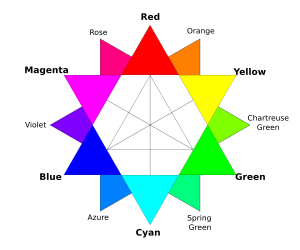Color wheel facts for kids
A color wheel is a round chart that helps you see how different colors are related. It shows you the main colors, called primary colors, and the colors you get when you mix them, called secondary and tertiary colors.
The most common color wheel today is called the HSV color wheel. HSV stands for hue (the pure color, like red or blue), saturation (how strong or bright the color is), and value (how light or dark the color is). A digital version of this is the RGB color wheel. There are two main types of color wheels:
- The electronic color wheel (or computer color wheel) uses red, green, and blue as its main colors. This is what you see on screens like TVs and computers.
- The printer's color wheel uses magenta, yellow, and cyan as its main colors. This is what printers use to make colors on paper.
Contents
Primary Colors: The Building Blocks
(* Primary means first or main)
The electronic color wheel is used for things like televisions and computers. On this wheel, red, green, and blue are the primary colors. Magenta, yellow, and cyan are the secondary colors.
These three primary colors are the main colors of light. They are called additive colors because when you mix them, you add light together.
When you mix these three colors of light together, you get white light! A long time ago, people thought red, yellow, and blue were the primary colors for everything, but now we know that's not quite right for light.
Secondary Colors: Mixing the Mains
(* Secondary means second)
Secondary colors are made by mixing two primary colors of light. These are the main colors used in printing, so they are called the subtractive colors. This is because when you mix pigments (like paint or ink), you subtract light.
On the printer's color wheel, magenta, yellow, and cyan are the primary colors. When you mix these three colors of pigment together, you get black.
Tertiary Colors: More Mixing Fun
(* Tertiary means third)
Tertiary colors are made by mixing a primary color with a secondary color that is next to it on the color wheel. These colors are the same for both the electronic and printer's color wheels.
Here are some examples of tertiary colors:
- Orange is made by mixing red and yellow.
- Chartreuse green (or yellow-green) is made by mixing green and yellow.
- Spring green is made by mixing green and cyan.
- Azure is made by mixing blue and cyan.
- Violet is made by mixing blue and magenta.
- Rose is made by mixing red and magenta.
The 12 Main Colors on the HSV Color Wheel
The HSV color wheel usually shows 12 main colors. These colors are spaced out evenly around the wheel. They include all the primary, secondary, and tertiary colors we talked about.
Starting from red, here are the 12 major colors:
These 12 colors give you a full set of basic color names that are commonly used.
Old RYB Color Wheel
Before the modern color wheels, people often used a traditional red-yellow-blue (RYB) pigment color wheel. On this older wheel, red, yellow, and blue were seen as the primary colors. The secondary colors were orange, green, and violet.
The tertiary colors on the RYB wheel were names like:
This old system is still sometimes used in art classes, but the HSV/RGB system is more common in science and digital media.
Images for kids
See also
 In Spanish: Círculo cromático para niños
In Spanish: Círculo cromático para niños










